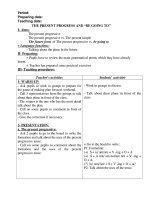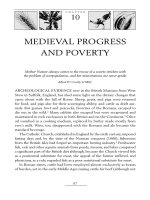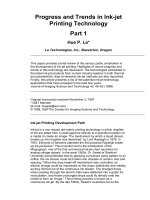MEDIEVAL PROGRESS AND POVERTY
Bạn đang xem bản rút gọn của tài liệu. Xem và tải ngay bản đầy đủ của tài liệu tại đây (280 KB, 16 trang )
97
CHAPTER
10
MEDIEVAL PROGRESS
AND POVERTY
Mother Nature always comes to the rescue of a society stricken with
the problem of overpopulation, and her ministrations are never gentle.
Alfred W. Crosby (1986)
1
ARCHEOLOGICAL EVIDENCE now in the British Museum from West
Stow in Suffolk, England, has shed some light on the dietary changes that
came about with the fall of Rome. Sheep, goats, and pigs were retained
for food, and pigs also for their scavenging ability, and cattle as draft ani-
mals. But guinea fowl and peacocks, favorites of the Romans, escaped to
die out in the wild.
2
Many rabbits also escaped but were recaptured and
maintained in rock enclosures in both Britain and on the Continent.
3
Olive
oil vanished as a cooking medium, replaced by butter made mostly from
ewe’s milk. Wine, too, disappeared with the Romans and ale became the
standard beverage.
The Catholic Church, established in England by the sixth century, imposed
fasting days and, by the time of the Norman conquest (1066), fi shermen
from the British Isles had forged an important herring industry.
4
Freshwater
fi sh, eels and other aquatic animals from ponds, streams, and lakes comprised
a signifi cant part of the British diet although, because the Church viewed fi sh
as a penitential substitute for meat, the appeal of the former suffered, and
physicians, as a rule, regarded fi sh as a poor nutritional substitute for meat.
In Roman times, cattle had been employed almost exclusively as beasts
of burden, yet in the early Middle Ages raising cattle for beef (although not
98
A Movable Feast
for milk) became increasingly common throughout Europe. Save for a few
regions, such as the Alpine valleys, cheese continued to be made from the
milk of sheep and goats. This pair, along with pigs, were far and away the
most popular barnyard animals according to early medieval documents.
They were remarkably small animals – perhaps a half or even a quarter the
size of their modern counterparts.
5
With the medieval mentality shaped by a self-conscious drive for self-
suffi ciency, another divergence from the days of the Romans was a move
away from an intensive concentration on wheat production to fi elds of
easier-to-grow crops such as rye, oats, pulses, cabbages, and turnips.
6
Onions,
leeks, and numerous herbs were tended for seasonings in medieval gardens.
In Wales, the leek became a badge after the Welsh fi nally paid some atten-
tion to Saint David’s (c.495–589) suggestion that they wear leeks on their
hats to distinguish themselves from the enemy in battle. They did this
while defeating the Saxons in 633 and, ever since, the leek has been worn
(then eaten) in a celebration of this ancient victory on St. David’s day.
7
The Norman conquest of 1066 brought to England new kinds of apples
and pears, as well as peaches, gooseberries, medlars, cherries, quinces, and
plums, and a bit later on, returnees from the Crusades carried back pome-
granates, along with a variety of spices and some notions of how to use
them. Cider making – the product called “perry” when made from pears –
was yet another contribution of the Normans.
8
In post-Roman Europe, rivers continued to be major arteries with goods
fl owing between the Baltic and the Black Sea along a network of water-
ways known by some as the “Amber Road.” Wine and foodstuffs advanced
northward along the Rhine and Oder rivers and their tributaries to be car-
ried by Viking merchants to England, Ireland, Norway, and Jutland, while
Hanse merchants transshipped them to peoples around the Baltic Sea. But
these river-borne comestibles frequently glided right past peasants strug-
gling, and often failing, to produce enough to feed themselves, let alone
urban populations.
9
Surpluses came gradually. In the sixth century, the Slavs had given Europe
a new plow – later known as the moldboard plow – that could cut much
more deeply into heavy soil than the scratch plough it replaced. Over time,
the new plow, pulled by oxen teams, opened new lands to cultivation and
initiated a shift from subsistence to market economies. Forests, the enemy
of the plow, were cleared to create fi elds – a process that was accelerated
after the eleventh century – and large collective farms that could afford the
Medieval Progress and Poverty
99
plow, and the eight or so oxen needed to pull it, come into being. Medieval
Europe built tens of thousands of water mills (according to the Doomsday
Book, England alone had 5,624 of them at the time of the Norman Conquest)
and then, beginning in the twelfth century, the power of the wind, harnessed
earlier in China and Persia, was also put to work in Europe for milling the
bounty generated by the new plow. Windmill sails became familiar sights on
the horizon.
10
And yet, in returning to one of our themes, the diets of the common
people worsened under the weight of these technological developments.
In a society that is relatively unstratifi ed, and one in which practically
everyone make a living from food production, most everybody will eat
roughly the same foods and there will be little difference in mortality
levels between the rich and the poor.
11
But, as Europe moved toward a
market economy, agricultural demands on the peasantry increased, a new
middle class emerged, and the kinds of foods that were, and were not, con-
sumed began to identify and differentiate. Upper- and middle-class diets
improved but that of the landless changed from one of some variety to one
of monotonous and restricted fare, varied only by seasonal supplements
that could be caught, grown, or gathered.
12
European secular and ecclesiastical upper classes shared a common
culture of eating and drinking well. Culinary standards were mostly
French and Italian, although recipe collections and cookbooks indicate
that regional cuisines had yet to develop.
13
Some peoples, however, had
developed specialties – the Dutch, for example, whose cheeses, butter,
and horticultural expertise were renowned.
14
In fact, Catherine of Aragon
had salad ingredients delivered to the English Court by special courier
from the Netherlands, and the Dutch are credited with introducing garden
vegetables to many areas of Europe.
15
Meats became expensive – conspicuous consumption for the well-to-
do who were also able to escape the restrictions of local food production
by recourse to a burgeoning commodity trade.
16
Said to have had 2,000
cooks in his kitchens and 300 servers, Richard II of England (1367–1400)
was clearly among the conspicuous consumers.
17
The less affl uent ate
meat sparingly and, consequently, what they could lay hands on needed to
be preserved – as sausages, smoked and salted meats, and salted herring
and cod – all of which came to be despised by those who could afford
better.
18
For their part, the elites consumed veal and kid with gusto in the
spring, when the astronomical and alimentary calendars had once more
100
A Movable Feast
aligned, and, during the last couple of centuries of the Middle
Ages, dined with considerable splendor on a very “Europe-
anized” menu that emphasized the exotic – centerpieces
of peacocks, swans, and herons, with spices employed
with abandon to fl avor and color foods.
Cereals, sometimes supplemented by pulses,
became the base of the diet of a peasantry that,
after the ninth and tenth centuries, was unable
to legally hunt animals or gather acorns and
chestnuts, as wooded areas were now the prop-
erty of the rich and powerful. An exception,
however, lay in a belt running through moun-
tainous regions from Portugal to Turkey, where
rural peasants actually subsisted on chestnuts
(Castanea sativa ), whose trees the Romans
had scattered about. These sweet nuts – loaded
with starch and a staple for some since hunter-
gatherer times – constituted the bulk of the
diet for many from the beginning of settled
agriculture until the mid-nineteenth century. Chestnuts were ground
into a fl our for porridge and bread-making (in northern Italy the chest-
nut is still called the “bread tree”), and lucky was the peasant who had
several older trees. New trees do not bear fruit for 15 years after plant-
ing and their yield is less than optimal until they have been around for a
half-century.
19
Barley, oat, and rye fi elds that decorated the northern European coun-
tryside were joined by buckwheat (another hardy grain that grows where
most other grains do not) during the fourteenth and fi fteenth centuries
(although legend would have it arriving somewhat earlier with returning
Crusaders). This native of Manchuria and Siberia, which had traveled west-
ward in leisurely fashion via Turkey and Russia, provided a little dietary
variety for the peasants in the form of pancakes and porridge.
20
Wheat – the preferred grain – grew well only in Europe’s southern-
most regions where pasta making began to fl ourish during the late Middle
Ages.
21
In many places cheese and butter were the poor man’s meat (called
“white meats”) – especially after the upper classes had decided to disdain
dairy products – but in late winter there was only grain, root vegetables,
dried beans, and pickled cabbage for the rural poor.
22
Medieval Progress and Poverty
101
Of course, winter had a nutritional impact on everyone, rich and poor.
Dietary splurges took place when hogs were slaughtered in September,
and cattle on November 11 – St. Martin’s day. The offal that could not be
preserved was turned into chitterlings, black puddings, and dishes of tripe
and kidneys. These were feasts not to be repeated until the following year
and, after this, peasantry and townspeople alike had to make do with what
they had been able to raise, preserve, and store.
That these foods constituted a far from satisfactory diet was evident
in early spring, when bleeding gums had people scratching beneath the
snow for the fi rst shoots of “scurvy grass” or, perhaps, for spinach that
also made an early-spring appearance in their gardens.
23
Spinach had fi rst
reached Europe with the invading Moors, but it was not until the end of
the Middle Ages that it showed up in a cookbook – this one published in
Nuremberg in 1485. Spinach was fi rst planted in England in 1568 and,
within a century, had become one of the few vegetables that the wealthy
would eat.
24
Depending on location, virtually everyone, during good times at least,
drank wine, or ale, perry, or cider (a good use for apples for over 2,000 years,
especially where grapes were not grown). Yet, the gap between the diets of
the rich and the poor grew ever wider to become a chasm during the two
major famines of the fourteenth century. Europe had suffered more than
its share of famines in the aftermath of Roman rule, and with famine came
the invariable cannibalism or at least rumors of cannibalism.
25
But there
had never been a Europe-wide famine before the onset of the Little Ice
Age at the end of the thirteenth century, which brought appreciably colder
temperatures – so cold, in fact, that the Baltic Sea froze over in 1303 and
again in 1306.
26
These deteriorating climatic conditions shortened growing
seasons to feed what had been steadily increasing populations (Europe’s
population had doubled, perhaps even tripled since 1,000), yet the famine
of 1315–1317 signaled the beginning of a demographic decline that con-
tinued through the famine of 1346–1347 to culminate in the appearance
of the Black Death in 1348.
27
Ominously, rats had become prevalent in Europe by the middle of the
fourteenth century and, even in the preceding century, had wrought havoc
by eating grain stores, seeds, eggs, even poultry. In fact, it was in 1284 that
the story of the Pied Piper fi rst appeared – the piper who piped the rats out
of the German town of Hamelin, then led the village children away after
the townspeople failed to pay him.
102
A Movable Feast
A few decades later the plague, which had begun earlier in China,
reached Europe to descend on those rats and then on humans to prune
populations weak with malnutrition by some 30 to 50 percent. If there
was a silver lining in this monumental demographic disaster, it was that the
plague sharply narrowed the dietary gap between rich and poor. Suddenly,
rural labor was in short supply and consequently better rewarded, as peas-
ants negotiated with landlords for rent reductions, even rent forgiveness,
and in some cases, became landlords themselves.
Nothing better illustrates a backpedaling elite in the face of population
losses to the plague than a 1363 act passed in England ordering that
artisans and craftsmen in towns, as well as the servants of the nobility, be
given meat or fi sh at least once a day in addition to their customary milk
and cheese allotments.
28
In northern Europe, livestock grazing increased
relative to grain production, and a trade developed between grassland
areas supplying meat and livestock and agricultural areas producing the
crops. For a brief period meat became so cheap that even the poor could
afford it.
29
Because of available fuel, however, that meat, along with other foods, was
cooked differently in northern as opposed to southern Europe. Despite con-
siderable deforestation wrought by agricultural expansion, wood remained
plentiful in the north where slow cooking and heavy meals were the norm.
Meats were roasted for hours on spits, and even the less affl uent, who at
least did not have to worry about wood, simmered porridges and soups of
cabbage and other vegetables, as well as some meat, or maybe just bones, in
cauldrons or pots over an open fi re. Bread was reserved for those who could
afford an oven.
30
By contrast, in the barren south, wood was a precious commodity. Much
of the timber that was cut became charcoal for metalworking; but charcoal
was also used in stoves to grill fi sh and vegetables and quick bake or boil
sheets of unleavened bread that, when sliced, became pasta in its many
sizes and shapes such as linguini, spaghetti, and the thread-like noodles
affectionately known as vermicelli (little worms).
31
Moreover, many Medi-
terranean dietary ingredients required no cooking at all and greens were
eaten in great quantities. Shoots of arugula or rocket ( Eruca sativa ), sorrel
(genus Rumex), lettuce (genus Lactuca), and garden cress (Lepidium sati-
vum) were chopped and torn into salads, seasoned with salt, oil, and a little
vinegar. The dichotomy between northern and southern diets was noted
by Giacomo Castelvetro (1546 –1615) at the beginning of the seventeenth









